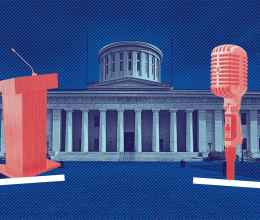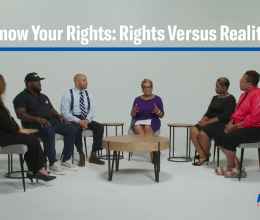For years, various groups organized around and lobbied against the Chief Wahoo image and the Indians name used by Cleveland’s baseball team, arguing that both were racist and morally offensive.
At various times these groups had tried to demonstrate on the sidewalks surrounding Jacobs Field, the local baseball field, in order to draw attention to their campaign. The property was controlled by Gateway Economic Development Corporation of Greater Cleveland. The sidewalks offered high visibility, as Indians’ home games attracted large crowds and extensive media coverage. Security officers frequently harassed and threatened to arrest demonstrators.
In March 2000, a coalition of religious, civic and American Indian groups led by the United Church of Christ, filed a lawsuit to assert the right to protest on the sidewalks and plazas near Jacobs Field. The ACLU of Ohio joined the lawsuit. Though the areas were open to the public and indistinguishable from the surrounding cityscape, Gateway maintained that they were privately owned and therefore not open to protesters as a matter of First Amendment right.
The challenge tested whether a nominally private corporation, overseen by a government appointed board and funded by tax revenues, could exclude the public from the sidewalks and pedestrian malls under its control. Along with local attorney Niki Schwartz, ACLU lawyers Raymond Vasvari and Jeff Gamso contended that efforts to exclude protesters from these areas violated their free speech rights because the stadium and arena were tantamount to government entities.
In March 2001, the district court ruled against the ACLU. Calling its decision a “very close call,” the Court held that the limited daily use of the sidewalks, and the limits imposed on their use during games, precluded them from being a public forum. The ACLU appealed this decision to the Sixth Circuit court. On September 1, 2004, the Sixth Circuit ruled that the sidewalks encircling the Gateway complex were public property for the purposes of First Amendment activity, while also ruling that the “Commons” areas (plazas, grassy areas, and interior streets) were not. The case was remanded back to the district court to consider whether the sidewalk restrictions were consistent with the First Amendment. On March 23, 2006 the case was settled, allowing the individuals to protest at four fixed locations on the sidewalks surrounding the Gateway complex.
Read the decision.





